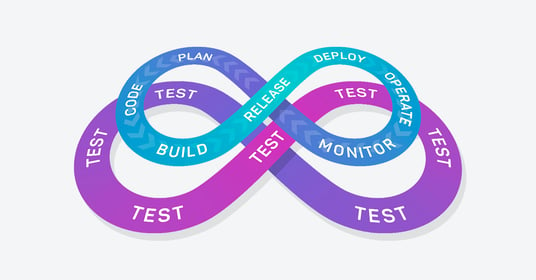Get a Free Trial
Creating, executing, and maintaining reliable tests has never been easier.
The ultimate goal of DevOps is to create a cyclical, continuous development pipeline that supports ongoing product expansion. The entire team is aligned on their goals, processes are consistent, and everyone has access to tools that empower them to contribute.
To adapt to this new reality, best practices like branching, version control, and peer review have emerged to allow different teams to work on new features or fixes simultaneously, removing the rigid processes that defined Waterfall development and allowing for iterative development and release. As organizations look to make their DevOps practices sustainable, they need to scale these best practices across the team, despite the diversity of skill sets that exist across developers, testers, and product owners.
Low-Code Unlocks Scalability for DevOps Teams
The core of scalable processes is feasibility. How many team members can participate in the process, and how often? Without repeatable processes that support a culture of quality, it’s impossible to scale testing across the entire DevOps pipeline. In DevOps, everyone in the development organization needs workflows that maximize their time and talents. Low-code tackles this challenge by lowering the barrier to entry for applying DevOps best practices.
Low-Code Branching Democratizes Experimentation Early in Development
Branching is a common DevOps practice that allows developers to create a new version of a feature in order to develop new fixes or capabilities without impacting the main product. It also unlocks iterative development by enabling developers to work on multiple versions of the same product simultaneously. For example, one team can work on a bug fix while another team builds a new capability.
But more often than not, software testing has been left out of this process since branching is usually a code-heavy process. A pillar of scalability - feasibility - was limited, which in turn limited quality engineers’ ability to scale collaborative testing. Low-code removes that barrier by enabling everyone to create new test branches, regardless of coding experience. Using low-code test automation, software testers can work in parallel on the same set of tests or flows, such as when a test is being updated or created for a new feature in development. This allows testing teams to match the pace of DevOps at the scale needed to unlock continuous testing.
Conflict Resolution and Peer Review Enable Quality Learning
As important as it is to create new test branches for testing at scale, it’s equally as critical to be able to manage different test branches so that the most accurate version is implemented at the correct stage of development. Otherwise, teams risk running the wrong test, potentially resulting in false fails or inaccurate test coverage.
Conflict resolution and peer review processes have long helped developers collaborate on branch management. Now, thanks to low-code test automation, quality engineering teams can do the same. Low-code merging and conflict resolution workflows enable all testers to understand what variables and steps differentiate test branches, making it easy for everyone to navigate rapidly changing tests and use the correct version for their projects. If a tester wants input from the rest of the team, test review workflows enable coworkers to share feedback directly on specific test versions. Knowledge sharing is streamlined and embedded directly into testing workflows so that the latest information is easily accessible. Testing is not only scalable, but becomes more reliable and effective as more team members contribute to their organization’s automated testing strategy.
Enabling DevOps Best Practices for Quality Engineering
DevOps is a shift in technology, procedure, and skills. Unless these pillars evolve in tandem, DevOps adoption will be a slow, ineffective process that leaves everyone frustrated. As organizations look to scale their testing strategies, they need to think holistically about what platforms and processes will encourage everyone to participate in their quality strategy. Low-code branching and peer review may be the missing piece to the quality-centric DevOps puzzle.
Take your DevOps practice to the next level with mabl’s two-week free trial. You’ll have access to low-code branch management practices that make scaling testing simple for DevOps success.






